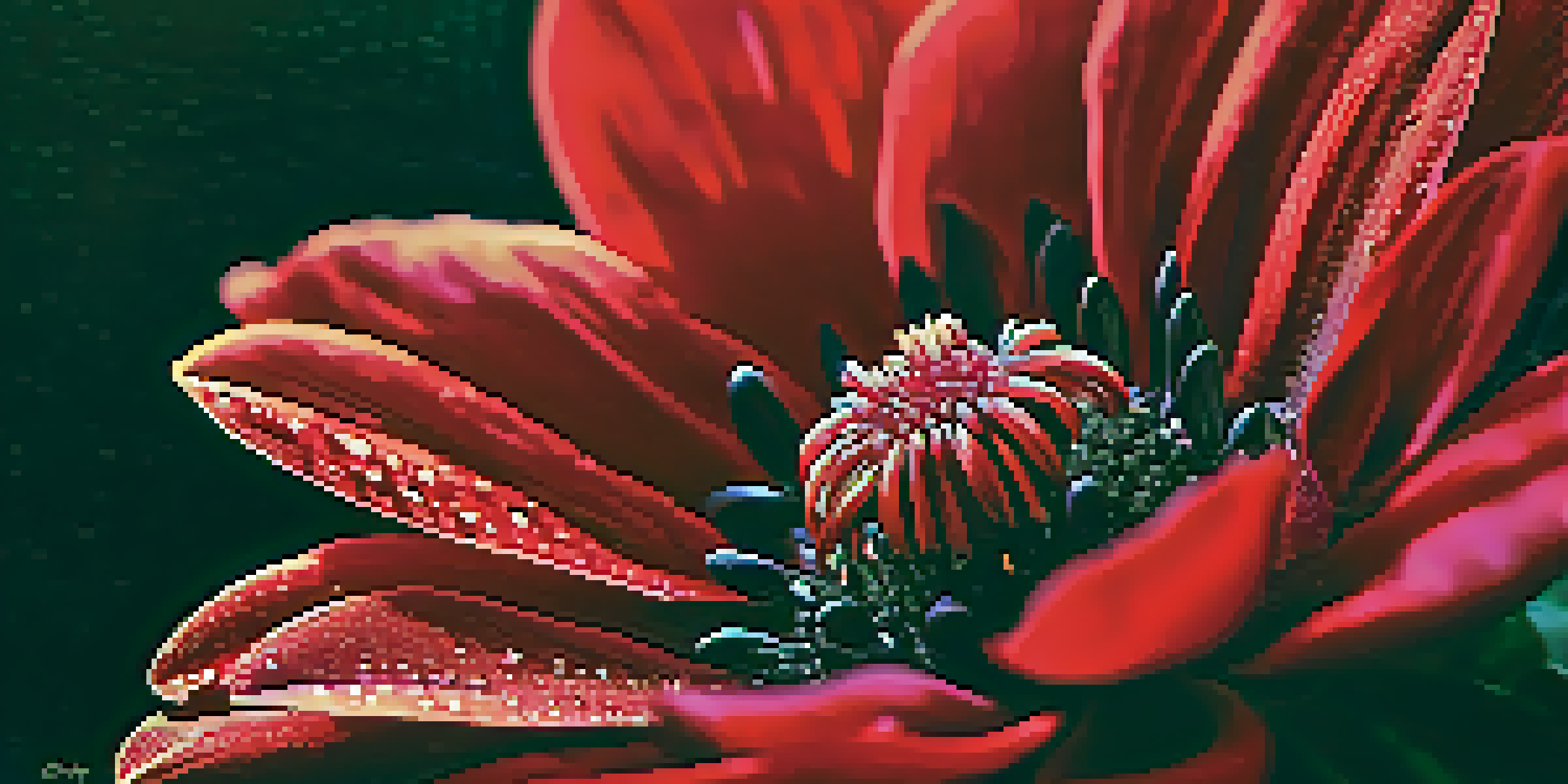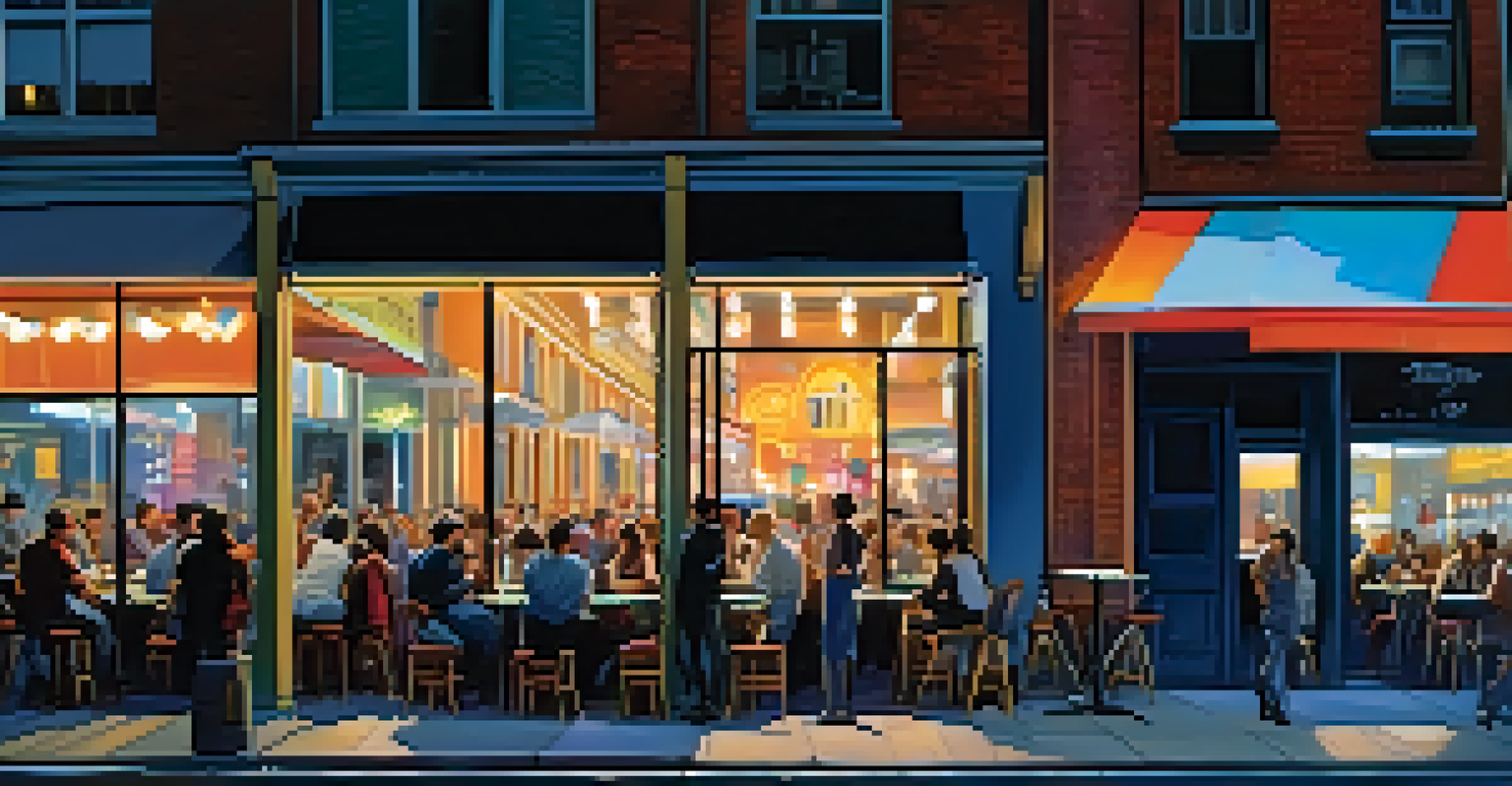Exploring the Impact of Color Contrast on Visual Storytelling

Understanding Color Contrast in Visual Storytelling
Color contrast refers to the difference in luminance or color that makes an object distinguishable from others. In visual storytelling, it plays a crucial role in guiding the viewer's attention and conveying meaning. By altering the contrast between elements, creators can evoke emotions and highlight key aspects of their narrative.
Color is the keyboard, the eyes are the harmonies, the soul is the piano with many strings.
For instance, a bright red object against a dark background immediately captures attention, creating a focal point. This technique is often used in films and advertisements to ensure that important details stand out. Understanding how to manipulate color contrast can significantly enhance the effectiveness of visual storytelling.
Moreover, color contrast can influence the mood of a scene. High contrast can create tension and excitement, while low contrast often conveys calmness and subtlety. By mastering these principles, storytellers can better connect with their audience and evoke the desired emotional response.
The Psychological Effects of Color Contrast
Colors have psychological effects that can alter perceptions and feelings. Bright, contrasting colors can energize viewers, while muted tones may create a sense of tranquility. Understanding these effects is essential for visual storytellers who want to evoke specific emotions through their work.

For example, a horror film might use stark contrasts with dark shadows and bright flashes to induce fear and suspense. Conversely, a romantic scene may employ softer contrasts to evoke warmth and tenderness. By strategically using color contrast, creators can manipulate viewers' emotions and enhance their storytelling.
Color Contrast Guides Viewer Attention
Manipulating color contrast effectively captures attention and emphasizes key elements in visual storytelling.
This psychological impact is not only limited to cinema but extends to graphic design, photography, and even website layouts. A well-thought-out color contrast can transform an ordinary image into a powerful narrative, making it memorable and impactful.
Color Contrast in Different Mediums
Color contrast manifests differently across various mediums, such as film, photography, and graphic design. In film, directors use lighting and color grading to create contrast that enhances the narrative. Photographers, on the other hand, rely on natural lighting and post-processing techniques to achieve striking contrasts in their images.
Colors are the smiles of nature.
In graphic design, color contrast is vital for readability and visual appeal. Designers must balance contrasting colors to ensure text is legible and the overall composition is aesthetically pleasing. This careful consideration can dramatically influence how effectively a message is communicated.
Each medium offers unique tools and techniques for leveraging color contrast, but the underlying principles remain consistent. Understanding these differences allows creators to adapt their storytelling approach depending on the medium they are working with.
Historical Context of Color Contrast in Storytelling
Historically, the use of color contrast has evolved alongside visual storytelling techniques. Early paintings often relied on limited color palettes, but as artists experimented with contrast, they discovered its power in conveying emotion and depth. This exploration laid the groundwork for modern storytelling methods.
In the film industry, the introduction of Technicolor in the 1930s revolutionized how color contrast was used to enhance narratives. Filmmakers began to understand that vibrant contrasts could evoke specific feelings and draw audiences into the story. This shift marked a significant turning point in visual storytelling.
Psychological Impact of Colors
Color contrast influences emotions, with bright colors energizing viewers and muted tones conveying calmness.
Understanding the historical context of color contrast helps contemporary creators appreciate its roots and apply these timeless principles in their work. By building on past techniques, storytellers can create innovative narratives that resonate with audiences today.
The Role of Color Theory in Contrast
Color theory is a foundational element in understanding how contrast works in visual storytelling. It encompasses the study of color relationships and how different colors interact with each other. By applying color theory, creators can develop harmonious color palettes that enhance the overall impact of their narratives.
For instance, complementary colors, which are opposite each other on the color wheel, can create striking contrasts that draw attention. Understanding these relationships allows storytellers to craft visually engaging stories that resonate with viewers on a deeper level.
Moreover, color theory can guide creators in choosing the right contrasts to match the mood of their narrative. By intentionally selecting colors based on their psychological effects, storytellers can amplify emotions and create a more immersive experience for the audience.
Practical Tips for Using Color Contrast
To effectively use color contrast in visual storytelling, start by identifying the primary emotions you want to evoke. Choose contrasting colors that align with these emotions, ensuring they complement the overall narrative. For example, if your story aims to convey urgency, high-contrast colors like red and black may be appropriate.
Experimentation is key! Test different color combinations and observe how they affect the viewer's perception. This hands-on approach can help you discover unique contrasts that enhance your storytelling. Remember, what works for one narrative may not work for another, so flexibility is essential.
Adaptation Across Different Mediums
Understanding how color contrast varies in film, photography, and graphic design helps creators enhance their narratives.
Additionally, consider accessibility when choosing color contrasts. Ensure that your contrasts are clear and legible for all viewers, including those with visual impairments. By being mindful of these factors, you can create compelling visual stories that resonate widely.
Case Studies: Successful Use of Color Contrast
Examining successful examples of color contrast can provide valuable insights for visual storytellers. Films like 'Sin City' utilize stark black-and-white contrasts with splashes of color to create a unique visual experience that enhances the narrative. This technique emphasizes key plot points and draws viewers into the story's emotional core.
Similarly, in graphic design, brands like Coca-Cola effectively use contrasting colors in their marketing materials to capture attention and convey their message. The red and white contrast not only makes their logo recognizable but also evokes feelings of excitement and energy.

These case studies highlight the importance of color contrast in creating memorable and impactful visual stories. By analyzing successful implementations, creators can learn how to apply these techniques in their own work, enhancing their storytelling abilities.